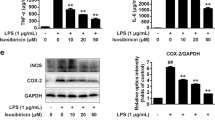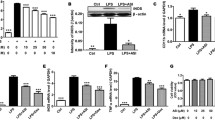Abstract
Natural products have proved beneficial in reducing neuroinflammation in neurological diseases. Their impacts have also been associated with the activities of microglia, responsible for brain-specific immunity. Recent studies have shown the involvement of the number of microglia-specific proteins in the regulation of brain-specific immunity. However, molecular targets of natural products and their mechanism of interaction with microglia-specific proteins are elusive. Since the genetic signature of microglia offers many potential targets for drug discovery, molecular docking followed by molecular dynamics (MD) simulations of cluster of differentiation 40 ligand (CD40L) and colony-stimulating factor 1 receptor (CSF1R) kinase domain protein with some known neuro-immunomodulators (Curcumin, Cannabidiol, Ginsenoside Rg1, Resveratrol, and Sulforaphane) has been evaluated. Curcumin and cannabidiol were observed likely to modulate CD40L and expression of cytokines and entry of inflammatory cells. Resveratrol and cannabidiol may affect the CSF1R kinase domain and activation of microglia. Our finding suggests that curcumin, cannabidiol, and resveratrol may serve specific drug ligands in regulating microglia-mediated brain immunity.





Similar content being viewed by others
Data availability
The datasets generated during and/or analyzed during the current study are available from the corresponding author on reasonable request.
Code availability
Not applicable.
References
Choi DK, Koppula S, Suk K (2011) Inhibitors of microglial neurotoxicity: focus on natural products. Molecules 16:1021–1043
Silva AR, Grosso C, Delerue-Matos C, Rocha JM (2019) Comprehensive review on the interaction between natural compounds and brain receptors: benefits and toxicity. Eur J Med Chem 174:87–115
Jin X et al (2019) Natural products as a potential modulator of microglial polarization in neurodegenerative diseases. Pharmacol Res 145:104253
Maurya SK et al (2021) Microglia specific drug targeting using natural products for the regulation of redox imbalance in neurodegeneration. Front Pharmacol 12:654489
Kim YS, Joh TH (2006) Microglia, major player in the brain inflammation: their roles in the pathogenesis of Parkinson’s disease. Exp Mol Med 38:333–347
Paolicelli RC et al (2011) Synaptic pruning by microglia is necessary for normal brain development. Science 333:1456–1458
Pont-Lezica L, Béchade C, Belarif-Cantaut Y, Pascual O, Bessis A (2011) Physiological roles of microglia during development. J Neurochem 119:901–908
Li Y, Du XF, Liu CS, Wen ZL, Du JL (2012) Reciprocal regulation between resting microglial dynamics and neuronal activity in vivo. Dev Cell 23:1189–1202
London A, Cohen M, Schwartz M (2013) Microglia and monocyte-derived macrophages: functionally distinct populations that act in concert in CNS plasticity and repair. Front Cell Neurosci 7:34
Cunningham CL, Martínez-Cerdeño V, Noctor SC (2013) Microglia regulate the number of neural precursor cells in the developing cerebral cortex. J Neurosci 33:4216–4233
Nayak D, Roth TL, McGavern DB (2014) Microglia development and function. Annu Rev Immunol 32:367–402
Squarzoni P et al (2014) Microglia modulate wiring of the embryonic forebrain. Cell Rep 8:1271–1279
Wohleb ES (2016) Neuron-microglia interactions in mental health disorders: “for better, and for worse.” Front Immunol 7:544
D’Aversa TG, Eugenin EA, Berman JW (2008) CD40-CD40 ligand interactions in human microglia induce CXCL8 (interleukin-8) secretion by a mechanism dependent on activation of ERK1/2 and nuclear translocation of nuclear factor-kappa B (NF kappa B) and activator protein-1 (AP-1). J Neurosci Res 86:630–639
Daoussis D, Andonopoulos AP, Liossis SN (2004) Targeting CD40L: a promising therapeutic approach. Clin Diagn Lab Immunol 11:635–641
Tang T, Cheng X, Truong B, Sun L, Yang X, Wang H (2021) Molecular basis and therapeutic implications of CD40/CD40L immune checkpoint. Pharmacol Ther 219:107709
Hagan N et al (2020) CSF1R signaling is a regulator of pathogenesis in progressive MS. Cell Death Dis 11:904
Sosna J et al (2018) Early long-term administration of the CSF1R inhibitor PLX3397 ablates microglia and reduces accumulation of intraneuronal amyloid, neuritic plaque deposition and pre-fibrillar oligomers in 5XFAD mouse model of Alzheimer’s disease. Mol Neurodegener 13:11
Spangenberg E et al (2019) Sustained microglial depletion with CSF1R inhibitor impairs parenchymal plaque development in an Alzheimer’s disease model. Nat Commun 10:3758
Mancuso R et al (2019) CSF1R inhibitor JNJ-40346527 attenuates microglial proliferation and neurodegeneration in P301S mice. Brain 142:3243–3264
O’Boyle NM, Banck M, James CA, Morley C, Vandermeersch T, Hutchison GR (2011) Open babel: an open chemical toolbox. J Cheminform 3:33
Jayaram B, Singh T, Mukherjee G, Mathur A, Shekhar S, Shekhar V (2012) Sanjeevini: a freely accessible web-server for target directed lead molecule discovery. BMC Bioinformatics 13(Suppl 17):S7. https://doi.org/10.1186/1471-2105-13-S17-S7
Cheng F, Li W, Zhou Y et al (2012) admetSAR: a comprehensive source and free tool for assessment of chemical ADMET properties. J Chem Inf Model 52(11):3099–3105. https://doi.org/10.1021/ci300367a (PMID: 23092397)
Volkamer A, Kuhn D, Grombacher T, Rippmann F, Rarey M (2012) Combining global and local measures for structure-based druggability predictions. J Chem Inf Model 52:360–372
Morris GM et al (2009) AutoDock4 and AutoDockTools4: automated docking with selective receptor flexibility. J Comput Chem 30:2785–2791
Laskowski RA, Swindells MB (2011) LigPlot+: multiple ligand-protein interaction diagrams for drug discovery. J Chem Inf Model 51:2778–2786
Adasme MF et al. (2021) PLIP 2021: expanding the scope of the protein-ligand interaction profiler to DNA and RNA. Nucleic Acids Res 49(W1):W530–W534
Bjelkmar P, Larsson P, Cuendet MA, Hess B, Lindahl E (2010) Implementation of the CHARMM force field in GROMACS: analysis of protein stability effects from correction maps, virtual interaction sites, and water models. J Chem Theory Comput 6:459–466. https://doi.org/10.1021/ct900549r
Schüttelkopf AW, van Aalten DM (2004) PRODRG: a tool for high-throughput crystallography of protein-ligand complexes. Acta Crystallogr D Biol Crystallogr 60:1355–1363
Lipinski CA, Lombardo F, Dominy BW, Feeney PJ (1997) Experimental and computational approaches to estimate solubility and permeability in drug discovery and development settings. Adv Drug Deliv Rev 23:3–25. https://doi.org/10.1016/s0169-409x(00)00129-0
Azam SS, Abbasi SW (2013) Molecular docking studies for the identification of novel melatoninergic inhibitors for acetylserotonin-O-methyltransferase using different docking routines. Theor Biol Med Model 10:63
Villar HO, Kauvar LM (1994) Amino acid preferences at protein binding sites. FEBS Lett 349:125–130
Drew ED, Janes RW (2020) Identification of a druggable binding pocket in the spike protein reveals a key site for existing drugs potentially capable of combating Covid-19 infectivity. BMC Mol Cell Biol 21:49
Pantsar T, Poso A (2018) Binding affinity via docking: fact and fiction. Molecules 23:1899
Sliwoski G, Kothiwale S, Meiler J, Lowe EW Jr (2013) Computational methods in drug discovery. Pharmacol Rev 66:334–395
Ma B, Shatsky M, Wolfson HJ, Nussinov R (2002) Multiple diverse ligands binding at a single protein site: a matter of pre-existing populations. Protein Sci 11(2):184–197
Berezhkovskiy LM (2007) On the calculation of the concentration dependence of drug binding to plasma proteins with multiple binding sites of different affinities: determination of the possible variation of the unbound drug fraction and calculation of the number of binding sites of the protein. J Pharm Sci 96(2):249–257
Karpusas M, Hsu YM, Wang JH, Thompson J, Lederman S, Chess L, Thomas D (1995) 2 A crystal structure of an extracellular fragment of human CD40 ligand. Structure 3(10):1031–1039
Singh J, Garber E, Van Vlijmen H, Karpusas M, Hsu YM, Zheng Z, Naismith JH, Thomas D (1998) The role of polar interactions in the molecular recognition of CD40L with its receptor CD40. Protein Sci 7(5):1124–1135
An HJ, Kim YJ, Song DH, Park BS, Kim HM, Lee JD, Paik SG, Lee JO, Lee H (2011) Crystallographic and mutational analysis of the CD40-CD154 complex and its implications for receptor activation. J Biol Chem 286(13):11226–11235
Sui Z et al (2007) Functional synergy between CD40 ligand and HIV-1 Tat contributes to inflammation: implications in HIV type 1 dementia. J Immunol 178:3226–3236
Elgueta R, Benson MJ, de Vries VC, Wasiuk A, Guo Y, Noelle RJ (2009) Molecular mechanism and function of CD40/CD40L engagement in the immune system. Immunol Rev 229(1):152–172
Karnell JL, Rieder SA, Ettinger R, Kolbeck R (2019) Targeting the CD40-CD40L pathway in autoimmune diseases: humoral immunity and beyond. Adv Drug Deliv Rev 141:92–103
Michell-Robinson MA et al (2015) Roles of microglia in brain development, tissue maintenance and repair. Brain 138:1138–1159
Oosterhof N et al (2018) Colony-stimulating factor 1 receptor CSF1R regulates microglia density and distribution but not microglia differentiation in vivo. Cell Rep 24:1203–1217
Martin-Estebane M, Gomez-Nicola D (2020) Targeting microglial population dynamics in Alzheimer’s disease: are we ready for a potential impact on immune function? Front Cell Neurosci 14:149
Marzan DE, Brügger-Verdon V, West BL, Liddelow S, Samanta J, Salzer JL (2021) Activated microglia drive demyelination via CSF1R signaling. Glia 69:1583–1604
Goldberg FW, Finlay M, Ting A, Beattie D, Lamont GM, Fallan C, Wrigley GL, Schimpl M, Howard MR, Williamson B, Vazquez-Chantada M, Barratt DG, Davies BR, Cadogan EB, Ramos-Montoya A, Dean E (2020) The discovery of 7-Methyl-2-[(7-methyl[1,2,4]triazolo[1,5-a]pyridin-6-yl)amino]-9-(tetrahydro-2H-pyran-4-yl)-7,9-dihydro-8H-purin-8-one (AZD7648), a potent and selective DNA-dependent protein kinase (DNA-PK) inhibitor. J Med Chem 63(7):3461–3471
Mohammad T, Siddiqui S, Shamsi A, Alajmi MF, Hussain A, Islam A, Ahmad F, Hassan MI (2020) Virtual screening approach to identify high-affinity inhibitors of serum and glucocorticoid-regulated kinase 1 among bioactive natural products: combined molecular docking and simulation studies. Molecules 25(4):823
Zhao Y, Zeng C, Massiah MA (2015) Molecular dynamics simulation reveals insights into the mechanism of unfolding by the A130T/V mutations within the MID1 zinc-binding Bbox1 domain. PloS one 10(4):e0124377
Yeni Y, Supandi S, Dwita LP, Suswandari S, Shaharun MS, Sambudi NS (2020) Docking studies and molecular dynamics simulation of Ipomoea batatas L. leaves compounds as lipoxygenase (LOX) inhibitor. J Pharm Bioallied Sci 12(Suppl 2):S836–S840
Lokhande KB, Doiphode S, Vyas R, Swamy KV (2021) Molecular docking and simulation studies on SARS-CoV-2 Mpro reveals mitoxantrone, leucovorin, birinapant, and dynasore as potent drugs against COVID-19. J Biomol Struct Dyn 39(18):7294–7305
Siraj MA, Rahman MS, Tan GT, Seidel V (2021) Molecular docking and molecular dynamics simulation studies of triterpenes from Vernonia patula with the cannabinoid type 1 receptor. Int J Mol Sci 22(7):3595
Anwar S, Mohammad T, Shamsi A, Queen A, Parveen S, Luqman S, Hasan GM, Alamry KA, Azum N, Asiri AM, Hassan MI (2020) Discovery of hordenine as a potential inhibitor of pyruvate dehydrogenase kinase 3: implication in lung cancer therapy. Biomedicines 8(5):119
Acknowledgements
SKM acknowledges Ramjas College, University of Delhi, Delhi for its continuous support and motivation.
Author information
Authors and Affiliations
Contributions
SKM and RM conceptualized the manuscript. SKM performed the experiments and wrote the initial draft of the manuscript. RM supervised the study, reviewed, and edited the manuscript. All the authors approved the manuscript before submission.
Corresponding author
Ethics declarations
Conflict of interest
The authors declare no competing interests.
Additional information
Publisher's note
Springer Nature remains neutral with regard to jurisdictional claims in published maps and institutional affiliations.
Supplementary Information
Below is the link to the electronic supplementary material.
Rights and permissions
About this article
Cite this article
Maurya, S.K., Mishra, R. Molecular docking studies of natural immunomodulators indicate their interactions with the CD40L of CD40/CD40L pathway and CSF1R kinase domain of microglia. J Mol Model 28, 101 (2022). https://doi.org/10.1007/s00894-022-05084-0
Received:
Accepted:
Published:
DOI: https://doi.org/10.1007/s00894-022-05084-0




